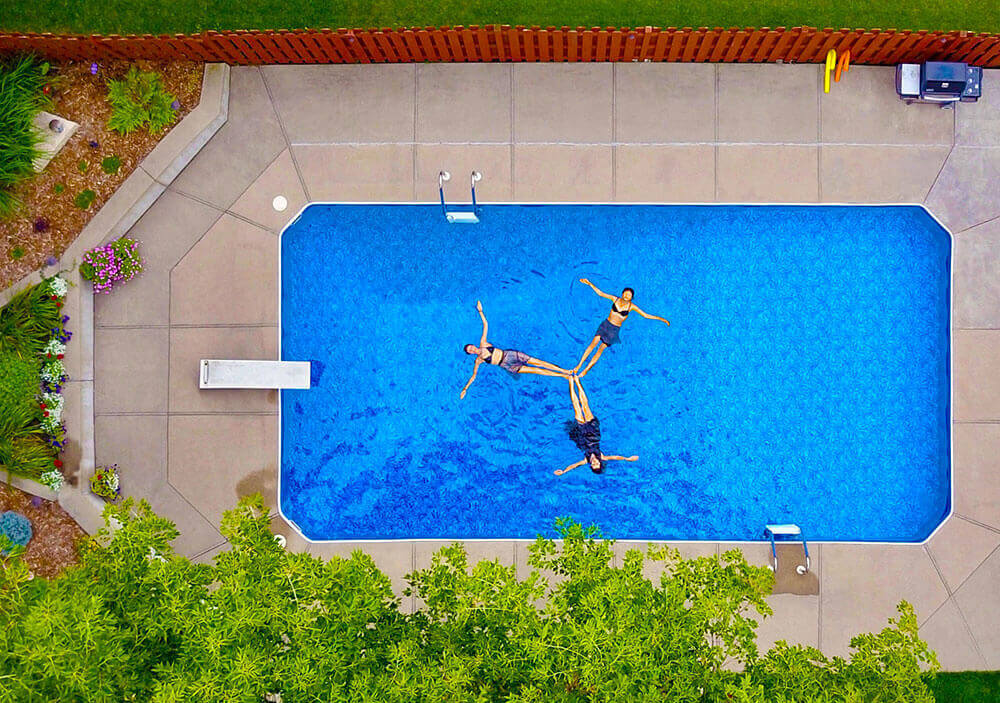
Discover the Many Ways You Can Benefit from Hydrotherapy with Inground Pools and Spas
For those suffering from aches, pains, stress, or simply want to use their backyard pool and spa to benefit their health and happiness, this article is for you.
There are several hydrotherapy uses, and each benefits your mental and physical health in different ways.
Use this guide to help you know how to use your inground pool and spa on a daily basis so you reach ultimate tranquillity and physical relaxation.
What Is Hydrotherapy?
Hydrotherapy is a water-based therapy used to treat a variety of physical and mental health conditions.
Humans have been using hydrotherapy since early civilization. Whether in Roman baths, or natural hot springs and cold rivers, cultures have been drawn to soaking in water because it is relaxing and provides plenty of relief from physical and mental stress and pain.
It is believed that in the 19th century, a Bavarian monk named Father Sebastien Kneipp developed the modern day use of hydrotherapy. Kneipp’s use of contrast hydrotherapy—alternating between hot and cold water—is still widely used today.
The main principles of hydrotherapy include the effects of hot and cold water on the body. Cold water causes superficial blood vessels to constrict, moving blood flow away from the surface and toward the body’s organs.
And hot water causes superficial blood vessels to dilate, activates sweat glands, and removes waste from the body.
Contrast hydrotherapy—alternating between hot and cold—decreases inflammation, increases circulation, and improves lymphatic drainage.
This water therapy can be performed in a backyard pool, spa, steam room, shower, bathtub, or a specialty hydrotherapy pool.
For a total therapeutic experience, you can design a custom backyard pool and spa with tranquil backyard landscapes to create the perfect environment for your hydrotherapy.
How Does It Work?
Hydrotherapy works in a few ways to provide a total physical and mental health treatment.
Buoyancy
The buoyancy of water helps lift up pressure and weight from your body. When immersed in water, upwards of 90% of pressure and weight is lifted from your body. This gives your muscles and joints get a break, allowing you total relaxation.
Heat
Heated spa water also relaxes the body and triggers the healing process. Heat feels good by relieving sore muscles and joints.
Heat increases blood circulation, boosting endorphins that naturally heal the body. Along with reducing pain, these endorphins also reduce anxiety.
Massage
Jets in spas and hot tubs massage the most stress-prone areas of your body, such as your neck, shoulders, and back. This massage relieves sore muscles and joints by releasing muscle tension and physical stress on your body. As a result, your whole body will feel more relaxed, you’ll sleep better, and you’ll feel better overall.
Cold Water and Warm Water Benefits
Hydrotherapy uses cold water, warm water, or a combination of both since they each offer health benefits.
Cold Water
When exposed to cold water briefly, cold water acts as a stimulant, making you feel more alert and energized. But extended exposure to cold water will actually make you feel more relaxed.
Cold water is helpful for repairing injuries, especially open wounds. Since cold water desensitizes peripheral nerve endings, cold water reduces pain from pressure and inflammation.
It also limits bleeding by constricting blood vessels and reducing blood flow. This helps damaged blood vessels begin to repair.
Cold water also encourages elimination, so your skin will push up dirt and debris that may be embedded deep in a wound.
Hot Water
Hot water helps redirect blood flow away from an injury, reducing pressure, inflammation, and pain.
To benefit from heat immediately after an injury, apply the heat to the uninjured side. This attracts blood flow away from the injury.
Do not apply heat or use hydrotherapy with an open wound as it will encourage bleeding. Instead, wait 24 hours so it is safe to take a warm bath or soak in a spa.
Types of Hydrotherapy
There are many types of hydrotherapy you can try at home. Here are three popular and effective methods.
The Kneipp System
As mentioned before, the Kneipp system of hydrotherapy uses both hot and cold to stimulate various physiological responses. To try this system at home, soak in your heated spa for 10 minutes and then take a plunge in your cold pool. Repeat a couple of times.
The Balneotherapy
This form of hydrotherapy uses both hot and cold mineral-rich bathing water to treat fibromyalgia, arthritis, and many skin conditions. Minerals such as radium, sulphur, and silica are found naturally in hot springs. But you can add your own spa-safe minerals to your spa water to benefit from Balneotherapy.
The HydroMassage Technique
Hydromassage is a form of massage therapy, but without the need for a registered massage therapist. Instead, a spa provides a mechanical (jets) and thermal (heat) body massage to increase circulation, release tension, and reduce pain.
How Hydrotherapy Benefits the Following
Osteoarthritis
Aquatic exercises can improve the pain and function of knees and hips with osteoarthritis.
Rheumatoid Arthritis
Combined with appropriate medication, hydrotherapy contributes to anti-inflammatory and antioxidant effects for those with rheumatoid arthritis.
Recovery after Athletic Activity
Many athletes use hydrotherapy for post-workout recovery. You’ve probably seen athletes plunge into a tub full of ice water after an intense workout.
But you don’t need to do that to help your recovery. Instead, soak in hot water or steam in a sauna to relax your muscles, improve circulation, and lower your blood pressure.
Afterwards, dive into a cold pool or take a quick cold shower. The drastic temperature change for your body will cause dilated blood vessels to contract, improving circulation, energy levels, and well-being.
Heat from a spa or sauna reduces muscle spasms and swelling, while soothing sore muscles. And increased circulation promotes healing and muscle repair.
Stress
Hydrotherapy reduces both physical and mental stress. The water’s buoyancy lifts up weight and pressure from your body, relieving stress from your muscles and joints.
And the soothing sounds and effects of bathing in water, along with the total relaxation, helps reduce stress levels and unwind after a long day.
*Important note: While hydrotherapy does offer many benefits for various health conditions, it should not be used as a substitute for medical treatments.
Other Benefits of Hydrotherapy
Water allows you to exercise without hurting your joints. Exercising while your joints are supported by buoyant water increases your range of motion.
And the resistance while moving in water builds muscles, coordination, and balance. You can do various exercises in water, including yoga, squats, and bicycle kicks.
Increased circulation boosts energy levels and promotes faster healing. Increased blood flow also boosts your immune system by circulating white blood cells and the lymph, removing unwanted materials from your body.
The relaxation of hydrotherapy reduces stress and blood pressure while releasing endorphins. Endorphins not only make you feel better but they also boost energy levels and immune system health.
And sweating during hot hydrotherapy removes toxins from your body.
Risk Factors: Don’t Practice Hydrotherapy Under These Circumstances
Hydrotherapy may not be recommended if you have any of the following medical conditions:
- High blood pressure or cardiovascular disease—since increased blood flow might put additional stress on the heart;
- Inflammation and acute injuries;
- Decreased sensitivity to hot and/or cold;
- Fever;
- Kidney disease;
- Cancer; and,
- Pregnancy.
If you have any of these conditions, consult with your health care provider to discuss whether you should practice hydrotherapy on your own.
Instead, and with the approval from your doctor, hydrotherapy can complement the treatments your doctor prescribes.
Hydrotherapy is something anyone can do in their own backyard and comes with so many physical and mental health benefits. So what are you waiting for? Improve your quality of life diving into your pool and try it for yourself!

Bert Minor has been a part of the landscaping business for nearly twenty years and has gained an excellent reputation as an innovative and creative designer. In fact, several of his designs and projects have been featured in industry supplier magazines. An active and contributing member of the industry, Bert sat on various boards including the Ottawa Chapter of Landscape Ontario and the Landscape Ontario Provincial Construction Committee. Bert also contributed technical articles published in the Canadian National Landscape Association magazine. With a relentless pursuit of knowledge, Bert has attained several industry certificates in landscape design, landscape construction and with the PHTCC—Pool and Hot Tub Council Canada. Prior to joining the landscaping industry, Bert spent several years in management in the services sector primarily in a customer advocate role. His honesty and integrity and his ability to build and develop strong relationships with clients reflects that.
